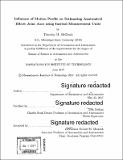Influence of motion profile on estimating anatomical elbow joint axes using inertial measurement units
Author(s)
McGrath, Timothy M. (Timothy Michael)
DownloadFull printable version (13.97Mb)
Other Contributors
Massachusetts Institute of Technology. Department of Aeronautics and Astronautics.
Advisor
Leia Stirling.
Terms of use
Metadata
Show full item recordAbstract
Current human motion measurement systems using inertial measurement units (IMUs) typically rely on precise alignment, static calibration poses, or dynamic calibration motions. Muller et al. recently proposed a method for online calibration of the human elbow anatomical joint axes via decomposition of angular velocity measurements. This thesis evaluated this calibration-free method in the context of two motion types. First, the method is evaluated with human-generated motions common to occupational rehabilitation, to investigate activities of daily living (ADLs) as online calibration motions. Second, the method is evaluated with parameterized sinusoidal motion, to investigate amplitudes and frequencies of motions that yield robust axis estimations. It was found for the axis of interest, high on-axis motion and low off-axis motion lead to precise axis estimation and high accuracy estimation of the pronation/supination elbow axis. Further, high off-axis motion and low on-axis motion yielded imprecise axis estimation and inaccurate estimation of both the flexion/extension and pronation/supination elbow axes. A comparative study of different filtering methodologies to the estimation of upper extremity human motion was also performed. Compared to a motion capture truth, the Extended Kalman Filter (EKF) and Unscented Kalman Filter (UKF) were found to perform similarly. An implemented particle filter (PF) was found to perform better than both the EKF and UKF, and on the order of accuracy of a manufacturers black-box algorithm. This work is the first to evaluate a particle filter in the estimation of human motion by inertial sensors. The particle filter was then subject to a sensitivity analysis of the error of its estimated 3D orientation to its underlying algorithm inputs, namely, the accelerometer and magnetometer uncertainties, and number of particles. Recommended operational levels for these parameters are reported. Future work will combine the Muller auto-calibration method, robust IMU orientation filters, and knowledge of appropriate online motions to develop an IMU bias correction method for long periods of measurement.
Description
Thesis: S.M., Massachusetts Institute of Technology, Department of Aeronautics and Astronautics, 2017. Cataloged from PDF version of thesis. Includes bibliographical references (pages 166-170).
Date issued
2017Department
Massachusetts Institute of Technology. Department of Aeronautics and AstronauticsPublisher
Massachusetts Institute of Technology
Keywords
Aeronautics and Astronautics.